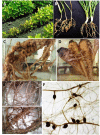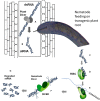Transgenic Strategies for Enhancement of Nematode Resistance in Plants
- PMID: 28536595
- PMCID: PMC5422515
- DOI: 10.3389/fpls.2017.00750
Transgenic Strategies for Enhancement of Nematode Resistance in Plants
Abstract
Plant parasitic nematodes (PPNs) are obligate biotrophic parasites causing serious damage and reduction in crop yields. Several economically important genera parasitize various crop plants. The root-knot, root lesion, and cyst nematodes are the three most economically damaging genera of PPNs on crops within the family Heteroderidae. It is very important to devise various management strategies against PPNs in economically important crop plants. Genetic engineering has proven a promising tool for the development of biotic and abiotic stress tolerance in crop plants. Additionally, the genetic engineering leading to transgenic plants harboring nematode resistance genes has demonstrated its significance in the field of plant nematology. Here, we have discussed the use of genetic engineering for the development of nematode resistance in plants. This review article also provides a detailed account of transgenic strategies for the resistance against PPNs. The strategies include natural resistance genes, cloning of proteinase inhibitor coding genes, anti-nematodal proteins and use of RNA interference to suppress nematode effectors. Furthermore, the manipulation of expression levels of genes induced and suppressed by nematodes has also been suggested as an innovative approach for inducing nematode resistance in plants. The information in this article will provide an array of possibilities to engineer resistance against PPNs in different crop plants.
Keywords: R genes; RNAi; plant parasitic nematodes; plant resistance; protease inhibitors.
Figures


Similar articles
-
The status of the CRISPR/Cas9 research in plant-nematode interactions.Planta. 2023 Oct 24;258(6):103. doi: 10.1007/s00425-023-04259-0. Planta. 2023. PMID: 37874380 Review.
-
Root endodermal barrier system contributes to defence against plant-parasitic cyst and root-knot nematodes.Plant J. 2019 Oct;100(2):221-236. doi: 10.1111/tpj.14459. Epub 2019 Sep 3. Plant J. 2019. PMID: 31322300
-
Biotechnological Tools to Elucidate the Mechanism of Plant and Nematode Interactions.Plants (Basel). 2023 Jun 20;12(12):2387. doi: 10.3390/plants12122387. Plants (Basel). 2023. PMID: 37376010 Free PMC article. Review.
-
RNA Interference: A Novel Source of Resistance to Combat Plant Parasitic Nematodes.Front Plant Sci. 2017 May 19;8:834. doi: 10.3389/fpls.2017.00834. eCollection 2017. Front Plant Sci. 2017. PMID: 28580003 Free PMC article. Review.
-
In vivo and In vitro Infection of Potato Roots with Plant Parasitic Nematodes for the Assessment of Induced Structural Changes.J Vis Exp. 2025 Feb 28;(216). doi: 10.3791/67756. J Vis Exp. 2025. PMID: 40095940
Cited by
-
Suppressing a plant-parasitic nematode with fungivorous behavior by fungal transformation of a Bt cry gene.Microb Cell Fact. 2018 Jul 23;17(1):116. doi: 10.1186/s12934-018-0960-5. Microb Cell Fact. 2018. PMID: 30037328 Free PMC article.
-
Resistance to Cereal Cyst Nematodes in Wheat and Barley: An Emphasis on Classical and Modern Approaches.Int J Mol Sci. 2019 Jan 19;20(2):432. doi: 10.3390/ijms20020432. Int J Mol Sci. 2019. PMID: 30669499 Free PMC article. Review.
-
Insights Into Genetic and Molecular Elements for Transgenic Crop Development.Front Plant Sci. 2020 May 15;11:509. doi: 10.3389/fpls.2020.00509. eCollection 2020. Front Plant Sci. 2020. PMID: 32499796 Free PMC article.
-
The status of the CRISPR/Cas9 research in plant-nematode interactions.Planta. 2023 Oct 24;258(6):103. doi: 10.1007/s00425-023-04259-0. Planta. 2023. PMID: 37874380 Review.
-
Strigolactones positively regulate defense against root-knot nematodes in tomato.J Exp Bot. 2019 Feb 20;70(4):1325-1337. doi: 10.1093/jxb/ery439. J Exp Bot. 2019. PMID: 30576511 Free PMC article.
References
-
- Ali M. A. (2012). Induction of Resistance Against Cyst Nematodes by Modifying Gene Expression in Syncytia. Ph.D. thesis, University of Natural Resources and Life Sciences, Vienna.
-
- Ali M. A., Abbas A. (2016). Analysis of reporter proteins GUS and DsRed driven under the control of CaMV35S promoter in syncytia induced by beet cyst nematode Heterodera schachtii in Arabidopsis roots.Adv. Life Sci. 3 89–96.
-
- Ali M. A., Abbas A., Azeem F., Javed N., Bohlmann H. (2015). Plant-nematode interactions: from genomics to metabolomics. Int. J. Agric. Biol. 17 1071–1082. 10.17957/IJAB/15.0037 - DOI
-
- Ali M. A., Abbas A., Kreil D. P., Bohlmann H. (2013a). Overexpression of the transcription factor RAP2.6 leads to enhanced callose deposition in syncytia and enhanced resistance against the beet cyst nematode Heterodera schachtii in Arabidopsis roots. BMC Plant Biol. 13:47 10.1186/1471-2229-13-47 - DOI - PMC - PubMed
Publication types
LinkOut - more resources
Full Text Sources
Other Literature Sources

